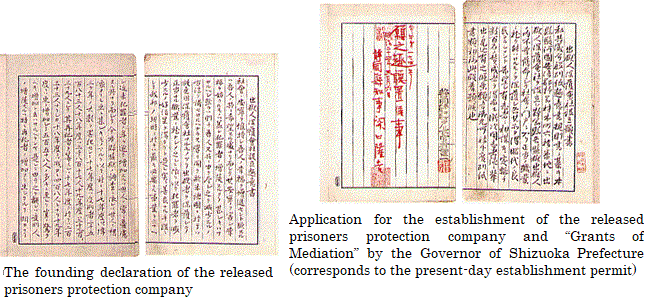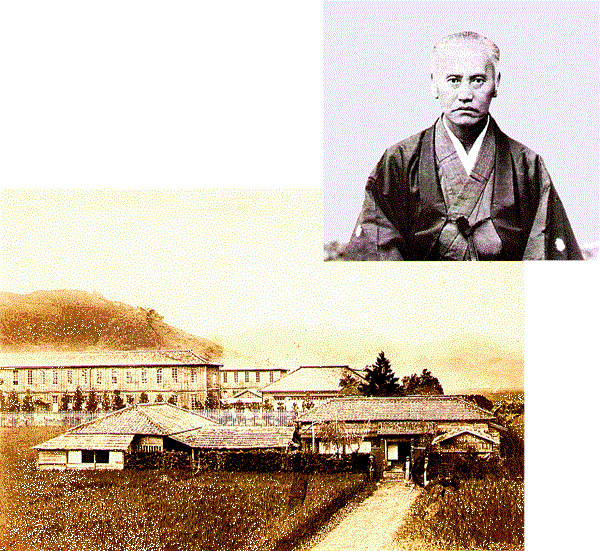History of Offenders Rehabilitation
The era of judicial rehabilitation services
The origin of modern offenders rehabilitation dates back to the Shizuoka Prefecture Released Prisoners Protection Company, which was established in 1888 by a group of volunteers led by Meizen Kimpara and Kyoichiro Kawamura (Note). The founding declaration of the company noted, “By protecting released prisoners who unfortunately cannot get legitimate jobs in the society, regaining their places and securing jobs, and thereby rehabilitating themselves . . . the company shall promote the well-being of released prisoners and maintain the well-being of the society.” The declaration matches precisely with the content of Article 1 of the Offenders Rehabilitation Act, which states: “The purpose of this Act is to provide proper treatment to persons that have committed crimes and juvenile delinquents, to prevent them from re-offending or stop their delinquencies and assist them to become self-reliant as sound members of society and improve and rehabilitate themselves, and to ensure the proper operation of pardons and promote crime prevention activities, etc., thereby protecting society and enhancing the welfare of individuals and the public.”
Along with the establishment of the company, groups of the protection of released prisoners were established by Buddhist groups, such as the Jodo Shinshu Hongwanji-ha, Shinshu Otani-ha, monks, and some Christians. These groups were mainly engaged in providing direct support to the released prisoners, such as food, clothing, and shelter. As the number of released prisoners increased significantly due to the great mourning pardon of the Empress Eisho in 1897, new types of protection groups were established to provide indirect support, such as guidance through visitation and correspondence, temporary support for traveling expenses, clothing, etc., while the released prisoners stay in their homes. This can be said to resemble the current probation system. Among them, there were also organizations that carried out direct support services and established branches to provide indirect support and temporary housing, such as the Fukui Fukuden Association, which was established in May 1909 by the Jodo Shinshu Hongwanji-ha Temples in Fukui Prefecture. Private judicial protection commissioners, who could be considered as the original form of volunteer probation officers, were appointed to the branch.
The rehabilitation services in Japan that started in such a way expanded further along with the growth of the private sector, and were gradually taken into the Japanese criminal justice system. Through the probation supervised by volunteer probation officers for juvenile rehabilitation of the old Juvenile Act and the probation of ideological criminals the services were incorporated into the national system when the Judicial Rehabilitation Services Act was enacted in 1939. Even after the rehabilitation project became a national project, the implementing agents were all private groups and volunteers. The judicial rehabilitation groups were responsible for arranging accommodation and providing temporary support, and the judicial rehabilitation commission was responsible for conducting supervision.

(Note) Gosaku committed suicide
At that time, there was a prisoner in Shizuoka Prison named Gosaku (a pseudonym), who was a repeat offender. He was known as a troublemaker by many of the prison guards but was deeply influenced by the heartful teachings of Mr. Kawamura, who was a vice warden (now is known as a prison’s vice director) and felt deep remorse of his actions. At the time of his release from the prison, he made a promise to Mr. Kawamura that he would “live a crime-free life” and never return to prison again.
Gosaku had been imprisoned for more than ten years. When he returned to his house, he was delighted to see that the persimmon tree at his home and the plants on his garden were as he remembered. The house was also the same as before, but it seemed that the people who lived inside it had changed. After looking at it for a while, he realized that his parents were not there anymore, and his wife had remarried someone else and lived happily with three children, who were not his. He could not go into the house and went to his relatives in the village and asked for a place to stay. However, he was refused and was told, “We cannot accept a criminal like you in our house.” He asked to stay for only one night at the corner of their garden but was also refused. He then went to a police station and asked to be sent back to the prison, but he was told that they could not arrest a man who had been released.
Gosaku had no place to sleep and no money to eat. In the past, he would have committed a crime as soon as he was released. However, he could not forget Mr. Kawamura’s teachings. He remembered his promise to Mr. Kawamura. A promise that he would never commit a crime again. In the end, he wrote a long letter to Mr. Kawamura and drowned himself in a pond outside the village.
Mr. Kawamura received the letter and heaved a deep sigh. He then told Meizen Kimpara of the detailed story when they met. Kimpara said, “Mr. Kawamura, your lectures did not benefit anyone if the person was killed. We need to think about ways to support and protect those who have learned their lessons and left the prison. You have always said that the Western countries have groups that support released prisoners. So, let’s start one in Shizuoka Prefecture.” The discussion between Meizen Kimpara and Mr. Kawamura, which later became the start of the released prisoners protection company, seemed to happen in 1887. The mission of these two men started here, and they initiated a movement to set up a released prisoner protection company by proposing the idea to influential people in the prefecture.
The episode triggered the establishment of the first Japanese offender rehabilitation facility in Shizuoka Prefecture. “Meizen Kimpara”, who lived his life as a businessman, a public worker when he worked as an officer of the soil and water conservation in the Tenryu River, an educator, and a founder of the offender rehabilitation service in Japan, was born in 1832 and died in 1923.

Development toward modern community corrections
After that, the “Offenders Rehabilitation Services Act”, which included the establishment of corporations for offender rehabilitation and others, was enacted in 1995. In 1999, a part of the Volunteer Probation Officers Act was revised, and there were movements toward the establishment of associations for volunteer probation officers and the federation of volunteer probation officers.
Furthermore, in June 2007, the Act for Prevention of the Re-generation of Criminals and the Act on Persons on Probation with Suspension of Execution of the Sentence were reorganized and consolidated into a new basic law of rehabilitation, known as the Offenders Rehabilitation Act, which was fully enacted on June 1, 2008. In the Offenders Rehabilitation Act, conditions in probation were set up and enhanced, the coordination of the social circumstances for the reintegration of prisoners and others was further improved, and a system that involves crime victims was introduced.
As mentioned above, current offender rehabilitation efforts were made possible through the activities of volunteers in the private sector and have been inherited by the volunteer probation officer system, and many other private groups, such as juridical person for offenders rehabilitation, Women’s Associations for Rehabilitation Aid and BBS. The Offenders Rehabilitation Act inherits the philosophy and tradition of offenders rehabilitation efforts that were established through the collaboration of the public and private sectors, and the law also serves as a basis for achieving further enhancements and developments. With the enforcement of this law, further improvement of various efforts in preventing subsequent offenses and supporting offender rehabilitation can be made.

